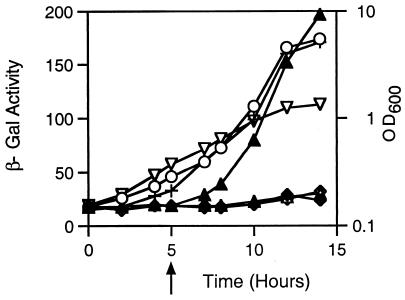FIG. 6.
TraR rapidly loses in situ activity after removal of C6-HSL. A culture of E. coli DH5α(pPBL1, pZLQR), which expresses traR, was incubated in A medium, and growth was followed turbidometrically (▿, OD600) as described in the legend to Fig. 5. At time zero, IPTG (100 μM) was added to induce expression of traR, the culture was split into four subcultures, and each was incubated for 1 h. 3-Oxo-C8-HSL (25 nM) (♦) was added to one subculture, and C6-HSL at two concentrations (○, 25 nM; ▵, 2.5 μM) was added to two subcultures. The fourth subculture (+) received no quormone. After 4 h of reincubation (arrow), cultures that received 3-oxo-C8-HSL or the high concentration of C6-HSL were harvested and washed extensively as described in Materials and Methods, and the resuspended cells from each culture were split into two subcultures. 3-Oxo-C8-HSL (♦, 25 nM) or C6-HSL (▵, 2.5 μM) was added to one of each of the subcultures, an equal volume of sterile water was added to the second (⋄, ▴), and growth was continued. Samples were taken from each culture at the indicated times and assayed for β-galactosidase activity. The experiment was repeated twice; results from one experiment are shown.

